Puerto Vallarta is an enchanting resort town on Mexico’s west coast in the state of Jalisco.
With miles of coastline flanked by the forested Sierra Madre mountain range, it’s a visually spectacular place to visit.
In addition to water activities in the Pacific Ocean, Puerto Vallarta is known for its authentic food, collection of art galleries, and artistic sculptures.
Jalisco is the birthplace of tequila and mariachi music, and there are frequent cultural festivals and events for visitors to participate in.
Local fishermen bring in fresh seafood daily, and rancheros offer horseback rides on the beach.

Whether you are looking for nightclubs, quiet beaches, family-friendly resorts, or adventures on the water, you can find it all in Puerto Vallarta.
Scuba Diving in Puerto Vallarta
Puerto Vallarta has a thriving scuba community made up of local guides, international instructors, and divers from all over the world.
Diving is possible year-round in Banderas Bay – one of the largest bays in Mexico.
There are many types of dive sites to choose from, including shore dives for beginners or discover scuba diving courses, and pinnacles for advanced divers.
Wrecks, tunnels, caverns, walls, and rocky reefs create a variety of landscapes all over the bay.
There are distinct seasons in Puerto Vallarta with different sea conditions that bring varying wildlife throughout the year.
Species that remain year-round include sea turtles, jacks, parrotfish, pufferfish, eels, lobsters, and eagle rays.
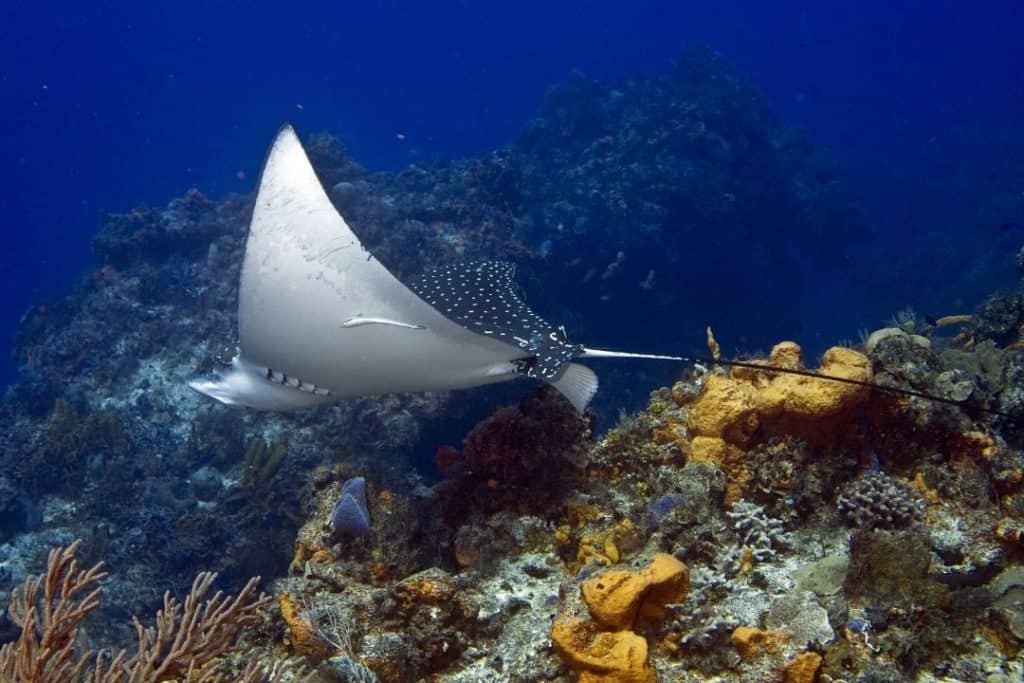
Sometimes lucky divers can glimpse a shy white-tip reef shark or an electric ray.
Octopuses like to hide in the rocks at almost every site, and macro fans can enjoy looking for tiny nudibranchs and arrow crabs.
In the warm summer months from July to October, the sea temperatures can be as high as 30°C (86°F) with up to 30 meters (100 feet) of visibility.
The average visibility is probably closer to 15-20 meters (50-65 feet). Seahorses hang out in the shallow sandy sites, while sea lions are sometimes sunbathing and swimming at the more remote boat ride sites.
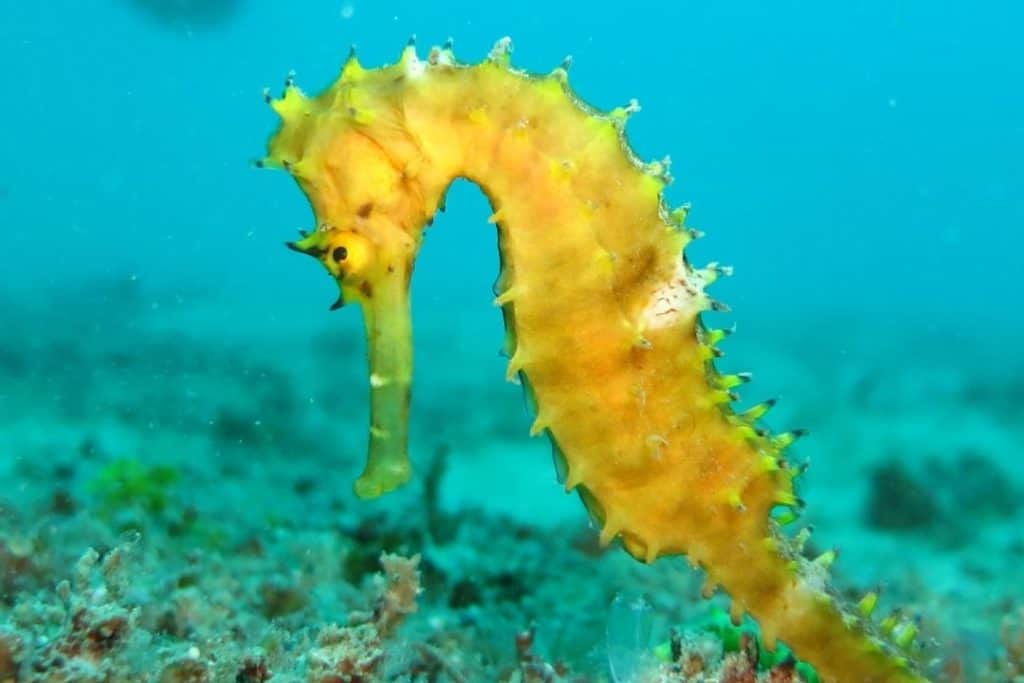
Most divers comfortably dive without a wetsuit during the summer.
The winter season from December to March brings migrating humpback whales that put on a spectacular show visible from the dive boat.
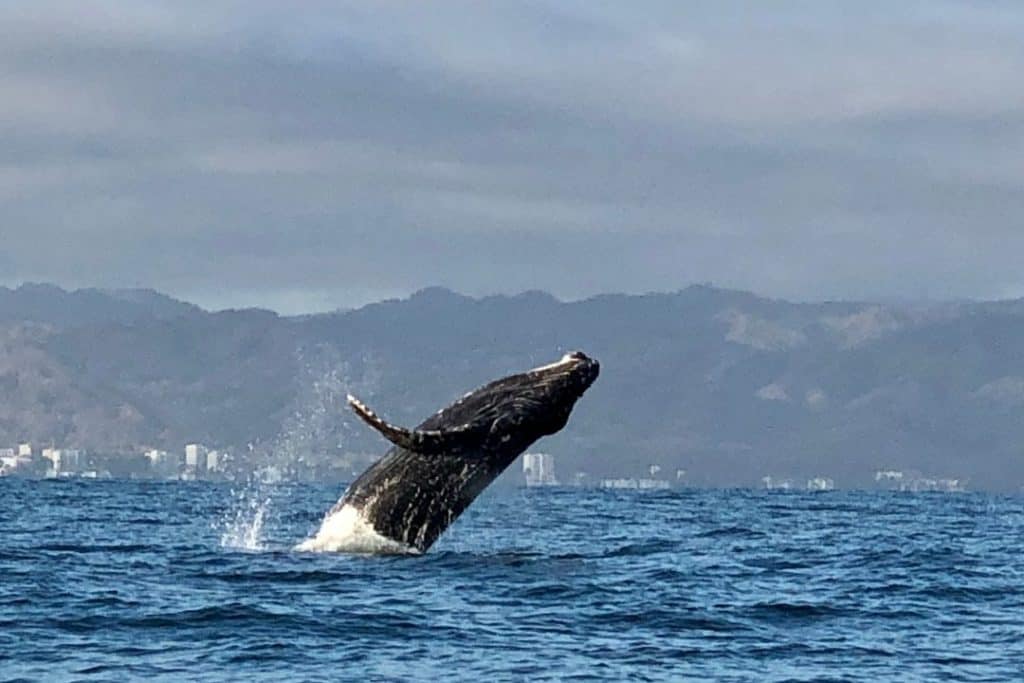
If they’re close enough, you can even hear their songs underwater during your dive.
The colder sea temperatures attract stingrays into shallower waters, so you can spot them swimming together or resting in the sand.
The water temperature averages about 23°C (73°F) in the winter, but can drop as low as 19°C (66°F).
There are usually one or more thermoclines where water of different temperatures forms layers, so the temperature can vary wildly during a dive.
Cold arctic currents bring nutrient-rich water to the bay, which attracts larger marine life like giant manta rays but also reduces visibility.
Visibility averages 5-15 meters (16-50 feet) in the winter. Most divers wear a 5-7 mm wetsuit in the winter.
Dive sites closer to shore usually have mild conditions and little current, especially in the summer when sea conditions are calm.
These sites are ideal for beginners or student divers.
Dive sites farther out into the bay frequently have strong currents that change rapidly and are reserved for experienced divers.
Best Diving Spots

Marietas Islands: The two Marietas Islands form a protected marine park and bird sanctuary.
Thousands of birds fly and nest around the islands, including the famous blue-footed booby.
Marietas usually offers calm conditions because the dive sites are protected from currents by the islands, so it’s a great place for newly certified divers.
There are sandy shallow areas with bright corals and abundant tropical fish as well as deeper areas with swimthroughs.
The wall on Island 1 features a long swimthrough at 18 meters (60 feet) and a large cavern. Green morays love to hang out in the rocks all over Marietas.
Since Marietas is a protected area, only certified divers are allowed to dive there with a guide.
Los Arcos
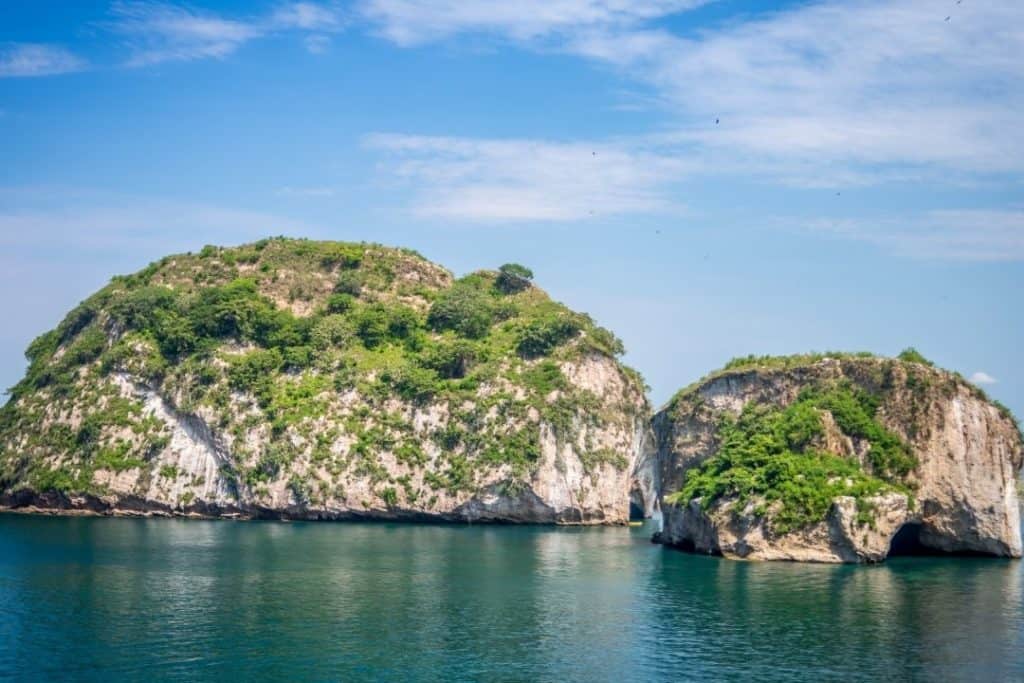
Los Arcos (“The Arches”) are impressive rock arches close to the shore at the southern end of Puerto Vallarta.
There are multiple sites at Los Arcos for beginners and advanced divers. Currents and conditions are usually mild.
The Aquarium
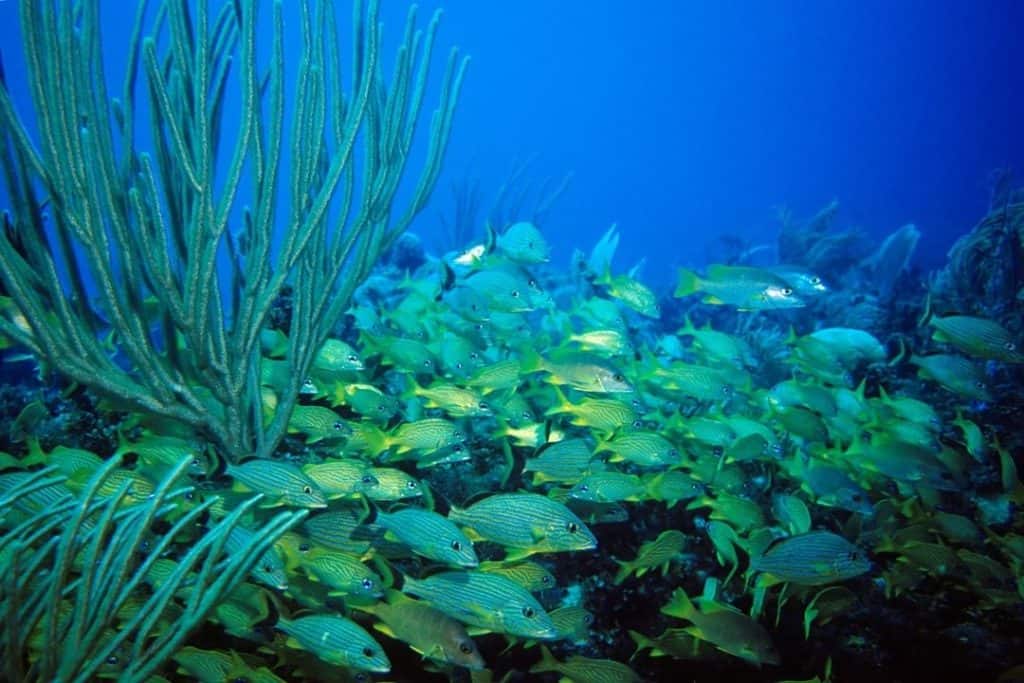
This shallow site has a maximum depth of 10 meters (33 feet) and is one of the best dive sites for students, beginners, or divers looking for a refresh.
The sandy bottom slopes down from the rocky island and provides a protected area where schools of grunts gather and lobsters hide in the rocks.
Devil’s Canyon
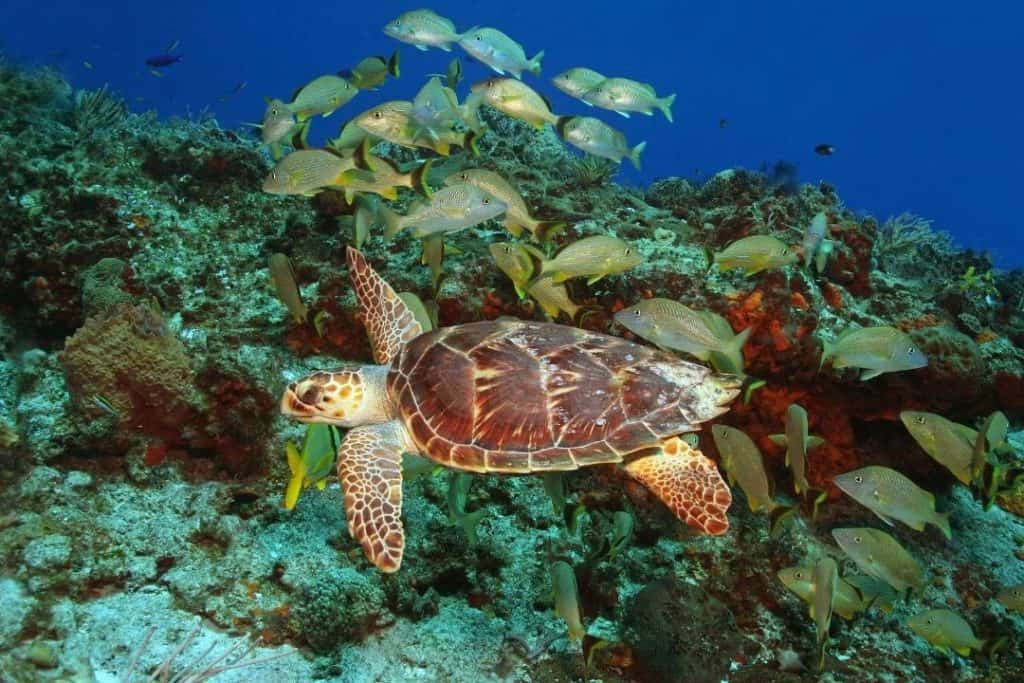
Moving deeper from The Aquarium, divers will pass through a tunnel to a spectacular wall to dive deep that drops over a thousand meters into the Banderas Trench.
Open water divers can remain at 18 meters (60 feet) while advanced divers can explore 30 meters (100 feet) along the wall.
This is a great place to spot turtles or an elusive manta ray.
Bajo de Cristo (“Christ Shallows)
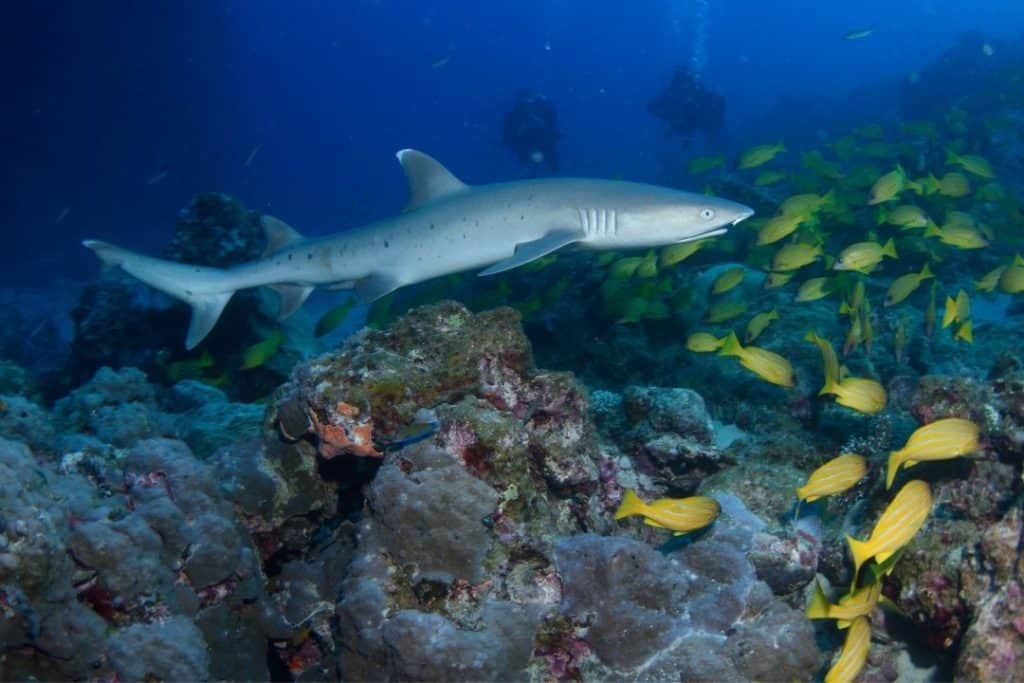
This site features both shallow and deep areas covered by rocky reefs and huge boulders. In the shallows, rays often lay in the sand, while the occasional turtle or white-tip reef shark rest in alcoves.
A tall pinnacle reaches from 25 meters (82 feet) almost to the surface.
El Morro
El Morro is a rocky pinnacle on the edge of Banderas Bay that can take 40 minutes to an hour to reach by boat.
El Morro features a large cave at 30 meters (100 feet) depth that leads to a long tunnel. Some parts of the tunnel are completely dark and require a flashlight to navigate.
Inside the tunnel, divers can sometimes find schools of snappers and sleeping turtles. The walls of the pinnacle are sheer and covered by corals and urchins.
Large rocks around the pinnacle create even more swimthroughs to explore. I’ve personally seen sea lions and manta rays at this site, and other instructors have seen whale sharks there. It tends to have better visibility than sites closer to shore, but the conditions can be extreme. Currents are strong and unpredictable, so only advanced divers can book a trip here.
Anegados
Anegados is a collection of rocky reefs and pinnacles 38 kilometers (24 miles) off the coast. The large rocks create a dynamic landscape of crevasses, arches, and swim-throughs on the sandy bottom.
Divers can sometimes see nurse sharks resting under rocky overhangs. Since this site is farther from shore than other sites, the visibility can occasionally be better – up to 30 meters (100 feet) – but usually an average of 15 meters (50 feet). The maximum depth is 24 meters (79 feet) and currents can be intense, so this site is best for advanced divers.
Caletas
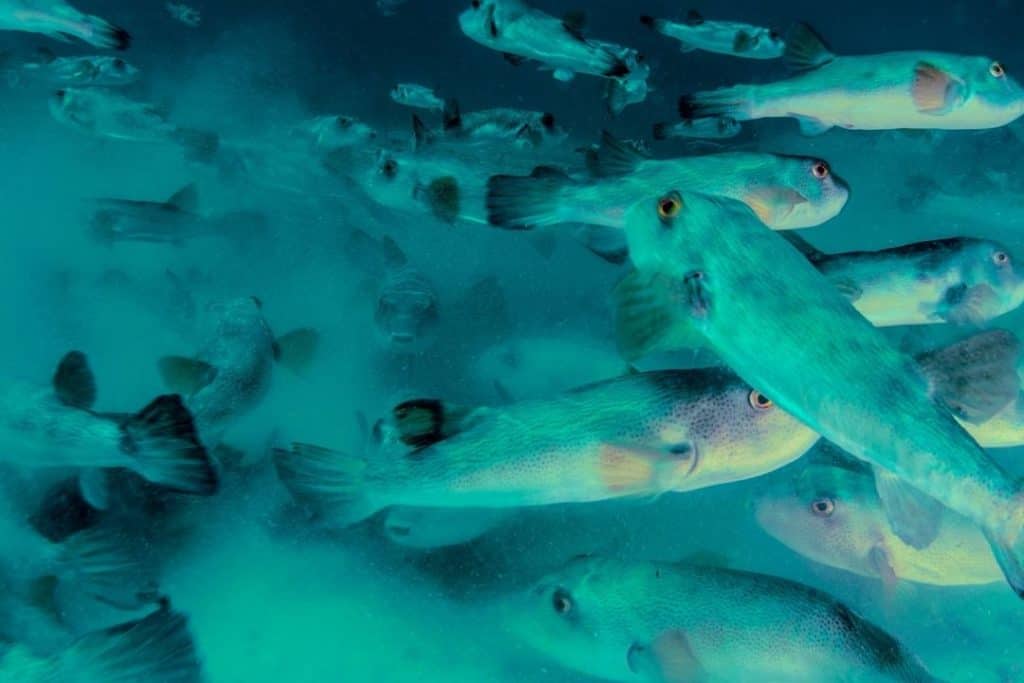
Caletas is a relaxing dive close to Caletas Beach south of Vallarta. It’s a popular spot for beginners to try diving for the first time because of its sandy bottom and lack of current. Divers enter the water from stairs on a wooden dock.
There are 2 small submerged boats, schools of pufferfish, and plenty of seahorses.
The maximum depth is 12 meters (40 feet). Tours to Caletas include access to the restaurant and hammocks along the beach.
Princesa Wreck
The Princesa was sunk in 2017 and is slowly turning into an artificial reef. It’s a 24-meter (80-foot) long ship resting on the sandy bottom.
Divers can enter and explore the ship so it’s a great place to get your wreck certification. With a maximum depth of 27 meters (90 feet), it’s a site for advanced divers.
Chimo
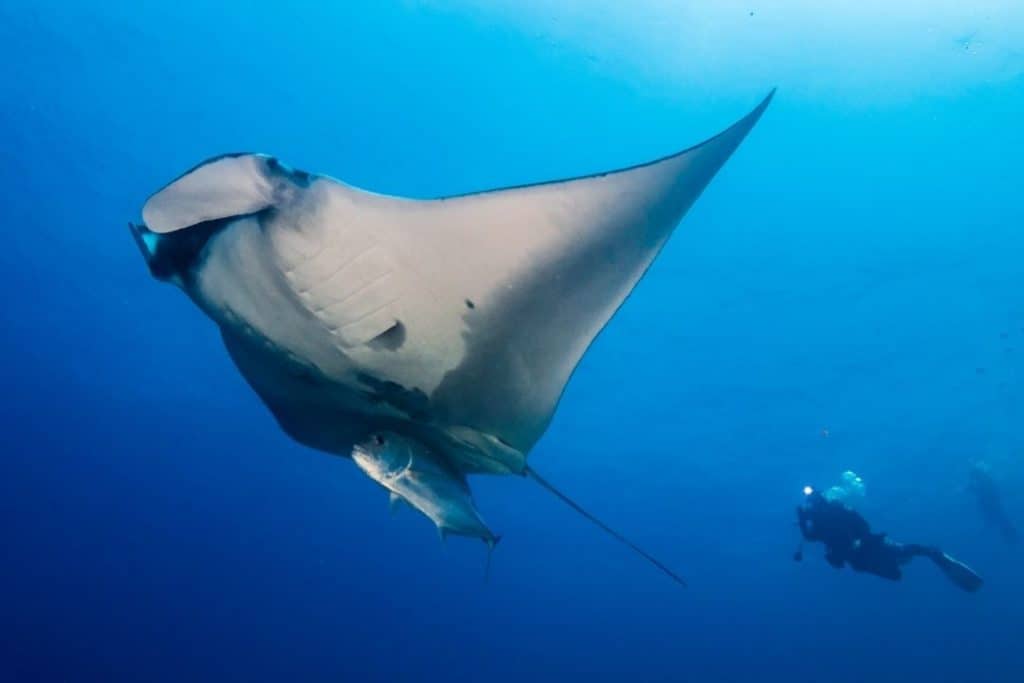
Chimo is a small fishing village south of Puerto Vallarta accessible only by boat. The dive site by the town features tall pinnacles called Las Iglesias that resemble the towers of a cathedral.
There are large rock formations and sheer walls dotted with corals. Since this is a more remote site, there’s a greater chance of seeing large pelagic species like mantas or loggerhead turtles.
With a maximum depth of 25 meters (80 feet), it’s a great site for advanced divers.
La Corbeteña
La Corbeteña the most remote dive site that Puerto Vallarta has to offer. El Sequial is another nearby seamount normally done on the second dive. Divers can spot schools of jacks and potentially large pelagic species.
From the boat, you may be able to spot pods of dolphins cruising near the surface.
Since the area is unprotected from wind and ocean currents, the conditions can be difficult and unpredictable.
With a maximum depth of 30 meters (100 feet), an advanced certification is required to scuba dive there.
El Sequial
There is an underwater tabletop rock formation here hundreds of meters long at 18 meters (60 feet) of depth. The walls around the tabletop drop off for kilometers, making this landscape a unique sight.
Majahuitas
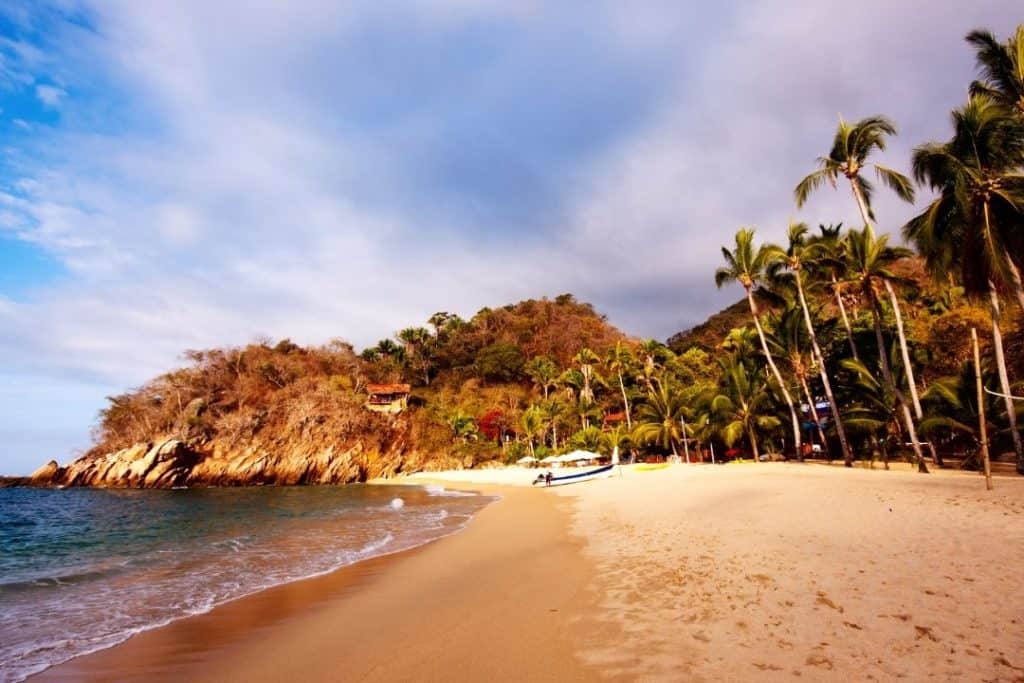
This hidden beach in a small bay is a beautiful destination for snorkelers and divers alike. Some tours will take you to the beach where you can do a discover dive from the shore, whereas dive tours drop certified divers directly over the reef.
Sloping rocks descend to a sandy bottom where garden eels peek out from the sand. This site is great for divers of any experience level.
Advanced divers can descend down to 24 meters (80 feet), while open water divers can stay in the shallower areas.
How to Get There
Puerto Vallarta has a busy international airport that receives flights from the U.S., Canada, Central America, Europe, and the U.K.
The airport is centrally located, making it easy to get to any part of the city.
Many popular cruise lines arrive at Puerto Vallarta’s cruise terminal, including Royal Caribbean, Princess, and Carnival.
Dive operators are familiar with cruise ship schedules and will be able to book a day trip to accommodate cruise ship passengers.
It’s possible to drive to Puerto Vallarta from anywhere in Mexico, the U.S., or Central America. Some roads are mountainous, but adventurous travelers make the journey all the time!
Where to Stay
Zona Romántica: The Romantic Zone at the southern end of the city is bustling and energetic. With cobblestone roads, restaurants, and galleries, the Romantic Zone is a favorite for many young or first-time visitors. This is the most LGBT-friendly area in Vallarta, although the whole city is very welcoming to visitors of all kinds. The Los Muertos pier and beach are top attractions
Downtown: The Centro (“Center”) of Vallarta is a charming area featuring colonial-style architecture and the famous boardwalk. Called the “Malecón”, this boardwalk features a seawall, sculptures, and an amphitheater for events. Most large nightclubs are right off the Malecón, as well as the central plaza and cathedral.
Hotel Zone: The Hotel Zone features large beachfront hotels and shopping malls. It’s less walkable than the downtown areas, but taxis and buses are easy to find. There are many lodging options here, from standard hotels to luxury, all-inclusive resorts.
Marina: The Vallarta Marina is close to the airport and has upscale residences and resorts. This area features high-quality restaurants, a golf course, and beautiful views of the boats at the docks.
Nuevo Vallarta: Nuevo Vallarta is a quiet resort area and features the nicest beaches in the city. The beaches here are long and wide with soft sand. This area is less dense and features upscale hotels, resorts, golf courses, and beachfront fine dining. It’s north of the airport and farther from the action of downtown, so visitors will need taxis or a rental car to get around.
Budget: Zona Romántica
Mid-Range: Centro
Luxury: Marina
Dive Shops
Vallarta Adventures: Vallarta Adventures is the largest puerto vallarta diving tour operator in the area and they offer trips to most of the dive sites in the bay. Many of the instructors have been working there for decades and know the dive sites extremely well. Vallarta Adventures has large tour boats that visit Caletas as well as smaller dive boats for the other popular sites. They offer fun dives and courses.
Banderas Scuba Republic: Banderas Scuba Republic is a small dive shop dedicated to personalized service on fun dives and courses. Their shop is located close to downtown and offers a selection of dive gear for sale. Their boats depart from the Los Muertos pier.
PV Ocean Tours: This dive shop offers courses, trips to popular dive sites, and private charters. They focus on safety and provide computers to buddy teams so everyone can monitor their dive.
FAQs
Is it safe to scuba dive in Puerto Vallarta?
Scuba diving in Puerto Vallarta is a very popular and safe activity.
All extreme sports come with risks, but as long as you follow your dive guide’s instructions and stick to your limits, diving in the bay is a fun and rewarding experience.
There aren’t any animals that pose a threat to divers aside from the occasional jellyfish.
Sites like Marietas and Los Arcos have considerable boat traffic, so it’s important to always inflate a surface marker buoy before surfacing. Your guide will certainly have one on hand for your group.
Some sites feature caves and long tunnels, so staying calm and using a flashlight will help you navigate them. Remote sites like El Morro can have extreme currents, so divers will need to follow their guide’s instructions and stay close to the group.
What’s the best time of the year to dive in Puerto Vallarta?
While scuba divers enjoy Puerto Vallarta all year round, the conditions vary considerably from season to season.
If you prefer warm and clear water, it’s best to scuba dive in the summer between June and November. The air temperature in the summer can reach a high of 32°C (90°F) with high humidity.
During the rainy season runs from July to October, rain and thunderstorms pass by the bay, but the sun still shines most of the day.
Rainy season also correlates with hurricane season, with August and September seeing the most hurricanes. While it’s unlikely that a hurricane makes landfall in Vallarta, even passing hurricanes can cause damaging winds and rains.
The dry season lasts from December to May. During this time, the skies are clear and the air temperature drops to an average of 22°C (72°F) but can reach as low as 17°C (62°F).
The sea temperatures drop, and cold currents bring nutrients to the ocean, clouding visibility.
December and January are considered the high season when prices are highest and most tourists visit the area. December to March is also the time when humpback whales visit the bay.
The shoulder season from March to May is a good time to visit Vallarta if you want to avoid the crowds, price increases, and rain.
How much does diving cost in Puerto Vallarta?
Scuba diving is affordable in Puerto Vallarta. Beginner dives without certification, known as discover dives, start around $140 U.S., and 2-tank guided dives for certified divers range from $100 to $200 depending on the dive site.
Open water and advanced courses are usually about $500. If you’re looking for private tours or luxury charters, you can find them starting at $500 up to thousands of dollars.
Tipping anywhere from 10-20% is customary in Mexico, so prepare to bring extra cash for your captains and guides. Most tour operators accept Mexican pesos and U.S. dollars.
Do you have to be certified to dive in Puerto Vallarta?
You don’t have to be certified to dive in Puerto Vallarta. Many dive shops offer complete beginner courses like discover scuba and open water, including pool sessions.
It’s also easy to find dive shops for specialty courses like deep, wreck, nitrox, and photography. If you’re looking to become a professional diver, you can even take your divemaster course in Puerto Vallarta!
Many dive sites in the bay are beginner-friendly. Other sites cater to advanced divers and specialty courses.
Conclusion
Puerto Vallarta is a well-rounded scuba destination that has something to offer every diver.
I featured Puerto vallarta in the best diving in mexico guide as well.
Do you have a question or another dive site you would add to the list? Leave a comment below!
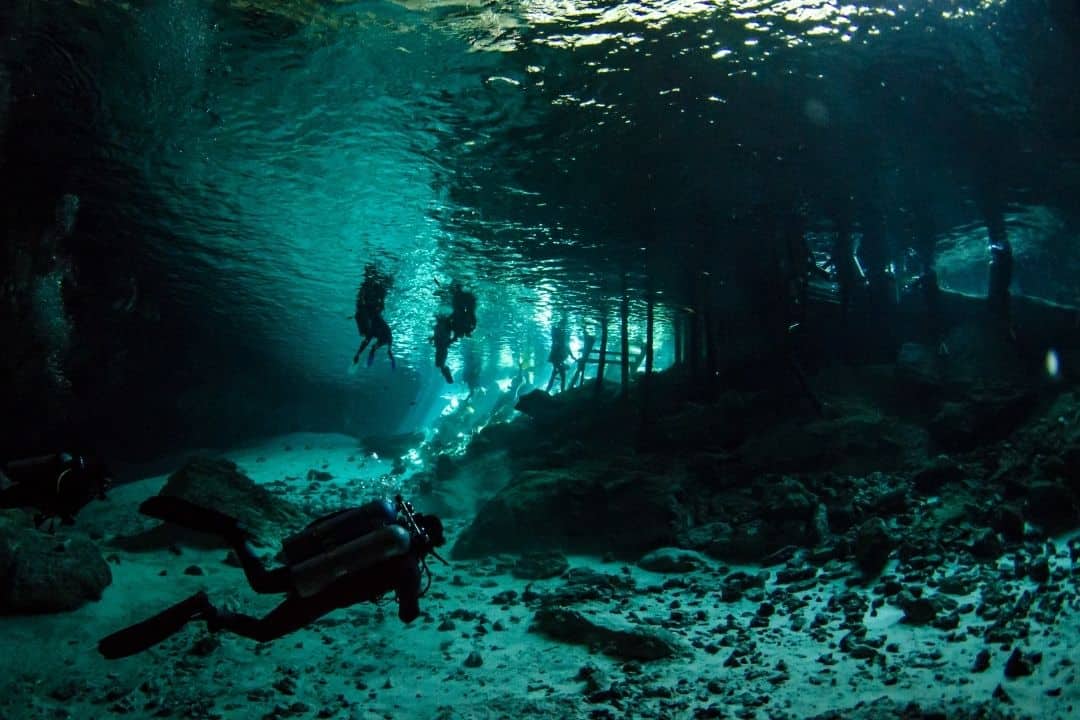

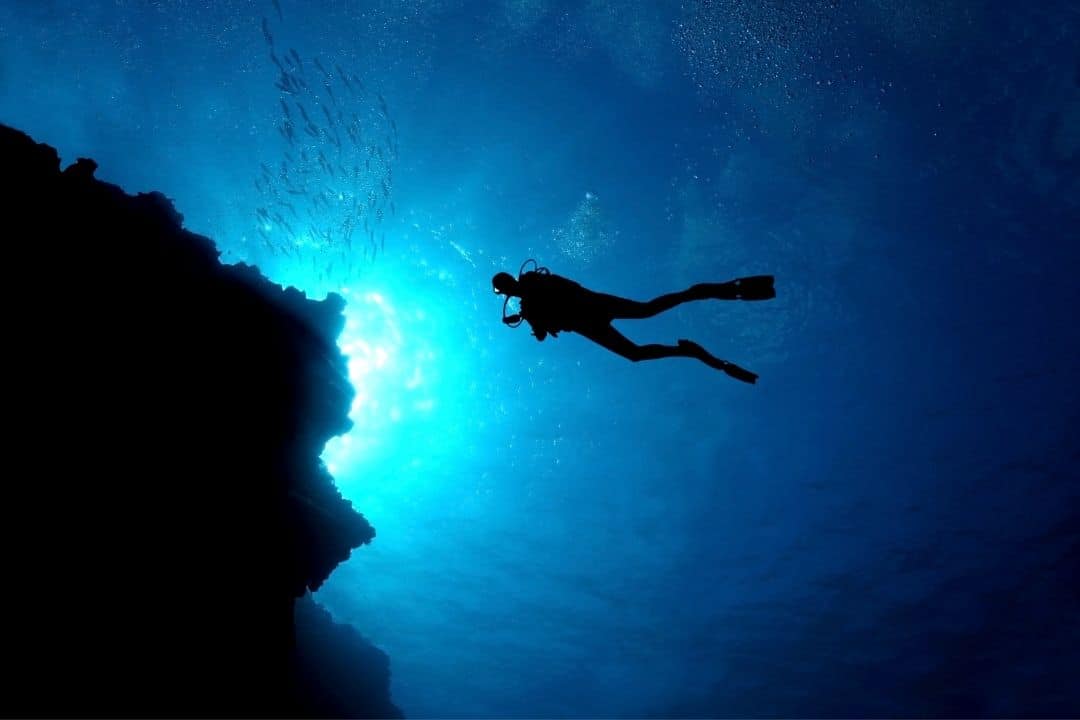
Thank you for doing this thorough guide!!! I really appreciate it.